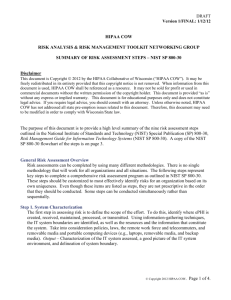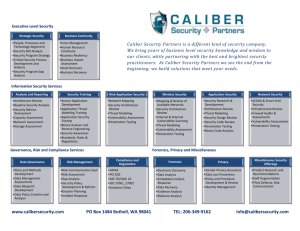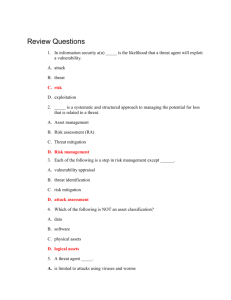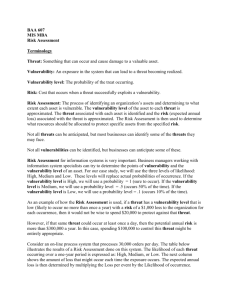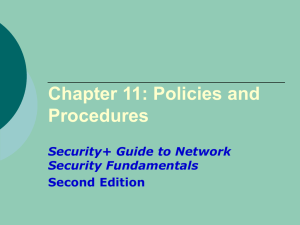Social Media Whitepaper
advertisement
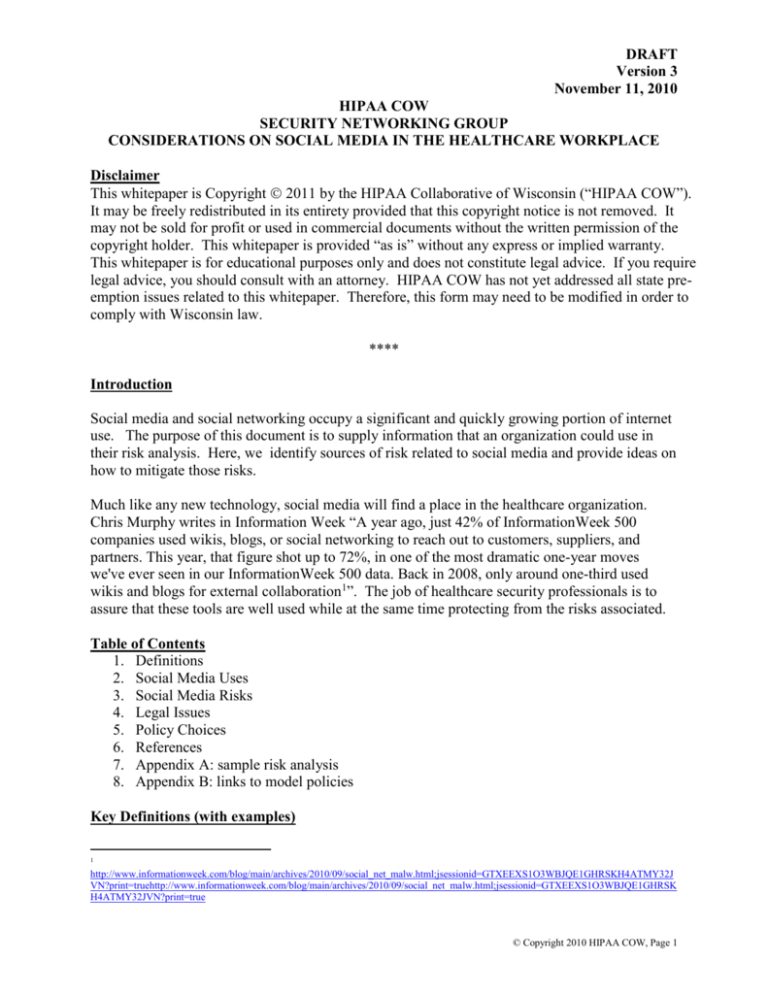
DRAFT Version 3 November 11, 2010 HIPAA COW SECURITY NETWORKING GROUP CONSIDERATIONS ON SOCIAL MEDIA IN THE HEALTHCARE WORKPLACE Disclaimer This whitepaper is Copyright 2011 by the HIPAA Collaborative of Wisconsin (“HIPAA COW”). It may be freely redistributed in its entirety provided that this copyright notice is not removed. It may not be sold for profit or used in commercial documents without the written permission of the copyright holder. This whitepaper is provided “as is” without any express or implied warranty. This whitepaper is for educational purposes only and does not constitute legal advice. If you require legal advice, you should consult with an attorney. HIPAA COW has not yet addressed all state preemption issues related to this whitepaper. Therefore, this form may need to be modified in order to comply with Wisconsin law. **** Introduction Social media and social networking occupy a significant and quickly growing portion of internet use. The purpose of this document is to supply information that an organization could use in their risk analysis. Here, we identify sources of risk related to social media and provide ideas on how to mitigate those risks. Much like any new technology, social media will find a place in the healthcare organization. Chris Murphy writes in Information Week “A year ago, just 42% of InformationWeek 500 companies used wikis, blogs, or social networking to reach out to customers, suppliers, and partners. This year, that figure shot up to 72%, in one of the most dramatic one-year moves we've ever seen in our InformationWeek 500 data. Back in 2008, only around one-third used wikis and blogs for external collaboration1”. The job of healthcare security professionals is to assure that these tools are well used while at the same time protecting from the risks associated. Table of Contents 1. Definitions 2. Social Media Uses 3. Social Media Risks 4. Legal Issues 5. Policy Choices 6. References 7. Appendix A: sample risk analysis 8. Appendix B: links to model policies Key Definitions (with examples) 1 http://www.informationweek.com/blog/main/archives/2010/09/social_net_malw.html;jsessionid=GTXEEXS1O3WBJQE1GHRSKH4ATMY32J VN?print=truehttp://www.informationweek.com/blog/main/archives/2010/09/social_net_malw.html;jsessionid=GTXEEXS1O3WBJQE1GHRSK H4ATMY32JVN?print=true © Copyright 2010 HIPAA COW, Page 1 DRAFT Version 3 November 11, 2010 Social Media: social media is the general term used to describe any number of tools intended to facilitate the public sharing and discussing of information. Facebook, MySpace, LinkedIn, Twitter, YouTube, AIM, etc, are all social media tools, although they are of different types Social Networking: social networking is a subset of social media, and is generally considered to include web-based tools for posting and sharing personal information. Facebook and MySpace are the two best known social networking sites, although there are many others Professional Networking: another subset of social media, professional networking sites are similar to social networking sites, except they are focused on the sharing of business or professional information (as opposed to personal). LinkedIn is a key example of a professional networking site. Chat / Instant Messaging: generally, utilities that allow real-time communication between two or more people using the Internet (including video, audio, and file transfer capabilities, as well as standard text). Chat / IM utilities may either be web-based or require an installed client, and are available on any device that has the ability to connect to the Internet, including cell phones, computers, etc. Twitter, AOL Instant Messenger (AIM), Yahoo Messenger, etc, are all considered to be instant messaging Blogs / Wikis: interactive websites for posting information on the Internet. 1. Blogs (from the original web-log) are generally less formal, and have fewer controls over access and content. They are commonly set up and used by individuals to share their personal thoughts, opinions, and beliefs. Blogger.com and blogspot.com are well known blog sites. 2. Wikis are more formal and have somewhat tighter controls, being used mostly as collaborative tools for gathering and disseminating information. Wikipedia is the best known wiki site. Media Sharing: as the name implies, these are websites used for uploading and downloading media file, including video, audio, and/or pictures. The files are stored on the server hosted by the site. YouTube is the best known video/audio sharing site. PhotoBucket and Shutterfly are examples of photo sharing sites. Peer-to-Peer (P2P): similar to media sharing, except these utilities create a dedicated connection between two computers over the Internet, and allow files to be transferred directly between them. The files are never stored on an Internet server. Napster is/was the best known utility of this type Social Media Uses Social media has moved from home use to an enterprise tool. Its potential cannot be estimated at this time, but based on adoption rates, it seems likely that some or all of the technologies are poised for continued and rapid growth. Some uses that are obvious today include advertising and fan pages. It is easier to set up than a web page for small practices. Many sites share basic © Copyright 2010 HIPAA COW, Page 2 DRAFT Version 3 November 11, 2010 health information. For a generation that grew up using social media, it is an obvious tool for posting and finding employment. Corporate information, reminder notices, customer and vendor contacts, investment information, weather-related closures are all additional examples of things which can be done with this family of technologies. The introduction of smaller, more mobile platforms such as iPhones and Droids is certain to increase the flow of hybrid, evolutionary applications, designed to benefit the enterprise, the client/patient or both. Other applications can only be imagined. For all the potential good, there are many risks associated with the use of social media. These are well documented, and in the case of the newer devices and technologies are only just evolving. Remembering back only a few years, computing was done on a larger and less portable device. The risks of today and tomorrow will not only be based on the applications themselves, but on the smaller and more portable devices we find them running on. Pictures of patients in emergency rooms get posted to Facebook. This happened to an accident victim at a hospital in Lake Geneva2. Patients have been discussed by their care givers. Names may not have been used, but still references to a patient in a certain room or a description of the patient or why they are being treated may still provide enough information to identify individuals. Negative comments can get posted about patients, co-workers, providers, working conditions, salary and benefits, or administration. A potential risk that should not be overlooked is that on many sites anything can be posted regardless of truth. These postings may include information that may be protected under HIPAA, or can affect your brand, reputation or good name. While you may be able to block or remove posted content, you will have no control of where it may have been copied to or who it was seen by. A disclosure or incident may have occurred which will require time and resources to address, even though your organization may have had nothing to do with posting it in the first place. Time gets wasted or work does not get done. Individuals spend time using social media tools when they should be doing things work related. A recent article in MLO reported the story of an individual who frequently called in sick when co-workers thought that she was not really sick. They searched her Facebook account and found postings concerning all the fun she was having on days when she had called in sick3. The speed at which individuals can post to social media sites allows individuals and corporate executives alike to post without thinking through what is being posted. If the individual took more time to think about what they were posting, it is quite possible that they would not post the information. Note that these issues are not substantively different from cafeteria or hallway conversations that we have been training healthcare workers about for decades. The difference is that social media 2 3 http://www.wisn.com/news/18796315/detail.html C. Anne Pontius, Addressing Management Issues, MLO October 2010, 26 © Copyright 2010 HIPAA COW, Page 3 DRAFT Version 3 November 11, 2010 postings stay around forever and can be spread literally over the entire world. (Interestingly, “going viral” is a term that is used to convey the explosive growth in popularity of a particular blog, posting or social media offering.) Very few overheard conversations could do that. There are two ways that individuals can use social media. They can log on using hardware owned by the organization. That is relatively easy to control. Web filtering software can be used to block or limit access. The alternative is to use their own hardware. Posting can be done either at home or on internet enabled telephones. Social Media Risks Social media has many advantages, but it has many risks, too. According to a report from NetworkWorld4 here is their top ten social media risks list: 1. Social Networking Worms 2. Phishing Bait 3. Trojans 4. Data Leaks 5. Shortened Links (for linking to malware) 6. BotNets 7. Advanced Persistent Threats 8. Cross-Site Request Forgery 9. Impersonation 10. Trust Cybercriminals are having success by committing crimes using social media. Here is a typical cybercriminal attack scenario using social media as the primary tactic: Step 1: The criminal will try to find compromised Facebook accounts or attempt to compromise Facebook accounts themselves. The reason that they do this is to impersonate the real Facebook account owner to attempt to deceive the owner's friends into providing personally identifiable information (PII); or trick victims into downloading malicious codes, which allows the criminal to take control of victims computers or spy on them to capture their sensitive data like bank account numbers, their company logons, etc. Step 2: The more friends that the actual Facebook owner has, the more targets that the criminal has to try to steal their sensitive data. The cybercriminal will look at all of the owner's friends to find these examples of data: 1. 2. 3. 4. 5. 4 Family last and first names Birthday Past and present addresses Phone numbers Work info http://www.networkworld.com/news/2010/071210-social-network-threats.html © Copyright 2010 HIPAA COW, Page 4 DRAFT Version 3 November 11, 2010 6. Medications or medical conditions 7. Places that they do business 8. Basically criminals look for any data that will eventually get to valuable information that can be resold in the underground economy Step 3: The cybercriminal will spend weeks, months and even years attempting to gain sensitive information or take control of victim’s computers; or use the victim's computers to gain access to other potential individual or company victims. In order for Covered Entities to protect the organization's, employee's and patients' sensitive information from criminals the Covered Entity needs to conduct a risk assessment and implement controls to mitigate the risks from social media. Attachment "A" provides a sample risk assessment of some of the risks associated with social media. Note: The sample social media risk assessment is only a sampling of some of the risks. The intent of Attachment "A" is to provide you a starting point for your overall social media risk assessment. Legal Issues “It’s quite clear; we don’t have a Facebook page." Supreme Court Justice Stephen Breyer on the need for the high court to adapt to the changing world of social media. There is little, if any case law that can serve as precedent related to social media in the healthcare organization. Certainly, an individual who posts patient identifiable information to their personal pages would be liable for their own actions. The question that needs to be addressed is which situations the employer would also be liable. Employers will need to include the subject of social media when they train their staff about privacy requirements of patient data. As with any training, this must be properly documented. As demonstrated by the Pachowitz case (Pachowitz v. LeDoux, 2003 WI App 120,265 Wis.2d 631,666 N.W. 2d 88), even when training has been completed and properly documented the organization may still be liable. Legal discovery of e-mail and other documentation is possible when done on an organization’s own network. When the data is stored on any one of the available social networking sites, legal discovery at best would be very expensive if it is even possible. Policy Choices When an organization is writing a policy related to social media, several choices must be made. For internal networks social media can be blocked completely, allowed for specific departments, or allowed throughout. Blocking for all requires that certain sites be put on a list that is never allowed. The organization will need to identify who will determine which sites to block. If certain departments are granted access to social media sites the organization will again need to determine which sites will be allowed and which departments. The most obvious example of a department that needs access to social media sites is a marketing department, but that department still needs to be limited. If all sites are allowed, the organization will need to clearly state when and how and for what purposes they can be used. While it is obvious that some sites because of © Copyright 2010 HIPAA COW, Page 5 DRAFT Version 3 November 11, 2010 their nature (pornography or hacking sites) must be blocked, final decision on blocking or allowing social media sites probably belongs with senior management. Any department that feels that they have a need should state a business case to allow access. For access on devices not owned by the organization and done on an individual’s personal time the organization needs to state that anything posted follows the same confidentiality rules that the individual has agreed to as part of their terms of employment. Use of personal devices, including smart phones and cameras within telephones, in the work place must be limited to break time and family emergencies. Photographs of patients should never taken without written permission. Any policy relating to social media should include a reminder that staff must not post personal information, either about their work situation, or their patients. ...... References 1. http://en.wikipedia.org/wiki/Social_networking 2. http://socialmedia.wikispaces.com/A-Z+of+social+media 3. http://www.livingstonbuzz.com/2009/02/24/social-media-glossary/ 4. http://www.converstations.com/blogging_glossary.html 5. http://onlinebrandmanager.org/social-media/social-networking-glossary/ 6. http://socialnetworking.lovetoknow.com/Social_Media_Terminology 7. Lake Geneva incident: http://www.wisn.com/news/18796315/detail.html 8. http://socialmedia.mayoclinic.org/ 9. http://www.informationweek.com/blog/main/archives/2010/09/social_net_malw.html;jse ssionid=GTXEEXS1O3WBJQE1GHRSKH4ATMY32JVN?print=true 10. Fired Google Engineer: http://www.csoonline.com/article/614581/engineer-fired-forprivacy-violations-google-says?source=CSONLE_nlt_update_2010-09-16 11. http://www.informationweek.com/news/globalcio/interviews/showArticle.jhtml?articleID=227300404 12. http://www.csoonline.com/article/619221/6-facebook-twitter-mistakes-that-can-get-youfired?source=CSONLE_nlt_update_2010-09-28 13. http://www.csoonline.com/article/584813/10-security-reasons-to-quit-facebook-and-onereason-to-stay-on14. http://www.csoonline.com/article/601614/brand-protection-and-abuse-keeping-yourcompany-image-safe-on-social-media 15. http://www.darkreading.com/authentication/security/privacy/showArticle.jhtml?articleID =227500908&cid=nl_DR_daily_2010-09-29_html 16. http://www.networkworld.com/newsletters/sec/2010/092710sec2.html?source=NWWNL E_nlt_security_strategies_2010-09-30 17. Ohio Medical Society guide: http://www.osma.org/files/documents/tools-andresources/running-a-practice/social-media-policy.pdf 18. http://www.itworld.com/offbeat/123789/nine-inch-nailed-trent-reznor-sticks-it-facebookzuckerberg?source=ITWNLE_nlt_thisweek_2010-10-14 19. C. Anne Pontius, Addressing Management Issues, MLO October 2010, 26 © Copyright 2010 HIPAA COW, Page 6 DRAFT Version 3 November 11, 2010 20. http://www.infoworld.com/print/140361 21. http://www.informationweek.com/news/smb/security/showArticle.jhtml?articleID=22790 0160&cid=nl_IW_daily_2010-10-19_html Facebook sharing user detail 22. Link to NetworkWorld Top Ten Social Media Risk List: http://www.networkworld.com/news/2010/071210-social-network-threats.html Authors Principal authors: Jim Sehloff, Lee Kadel, Larry Boettger HIPAA COW Security Networking Group Appendix A: Risk Analysis Threat/Vulner ability Source Identification Social Networking Worms, Trojans, Bots and other Malicious Codes Likelihood of Threat/Vulner ability Low Impact Magnit ude Analysi s Score High Overall Risk Determin ation Level Low Preventive Controls 1. Behaviorbased malware controls on every workstation 2. Information Security User Awareness Training Detective Controls Corrective Controls 1. Behaviorbased malware controls on every workstation 1. Incident Handling Procedures 2. Regular Vulnerability Assessments 2. Management Responses to Vulnerability Assessment Results 1. Incident Handling Procedures Phishing Attacks Low High Low Information Security User Awareness Training Regular Social Engineering Testing 2. Management responses to Social Engineering Testing Results © Copyright 2010 HIPAA COW, Page 7 DRAFT Version 3 November 11, 2010 ePHI and other Sensitive Data Leaks could be posted on employee's social media pages Inconsistent messages could be posted about the organization A cybercriminal could impersonate other people's social media pages and attempt to deceive friends of the impersonated account owner 1. Social Media Policy Low Low High High Low Low 2. Information Security User Awareness Training Social Media Policy: Only certain groups are allowed to post company information Regular monitoring of organization' s social media presence 1. Social Media Procedures: Information is proof-read and approved before being posted High Low 2. Information Security User Awareness Training Sanction Policy 2. Regular monitoring of organization' s social media presence 1. Social Media Policy Medium Sanction Policy Regular Social Engineering Testing Management responses to Social Engineering Testing Results Social Media Risk Assessment Column Name Definition Threat/Vulnerability Source Identification These are primary threats/vulnerabilities that could impact the organization if controls are inadequate © Copyright 2010 HIPAA COW, Page 8 DRAFT Version 3 November 11, 2010 Likelihood of the threat/vulnerability occurring based on nature of the threat/vulnerability and existence and effectiveness of current controls. Likelihood Definition: Likelihood of Threat/Vulnerability High = The threat/vulnerability source is sufficiently capable, and controls to prevent the vulnerability from being exercised are ineffective. Medium = The threat/vulnerability source is capable, but controls are in place that may impede successful exercise of the threat/vulnerability. Low = The threat-source lacks capability, or controls are in place to prevent, or at least significantly impede, the threat/vulnerability from being exercised. Impact Magnitude Analysis Score If threat/vulnerability occurs, damage that could affect organization's ability to meet stakeholder's, customer's and employee's interests Impact Definition: High = Exercise of the threat/vulnerability (1) may result in the highly costly loss of major tangible assets or resources; (2) may significantly violate, harm, or impede organization's mission, reputation, or interest Medium = Exercise of the threat/vulnerability (1) may result in the costly loss of tangible assets or resources; (2) may violate, harm, or impede an organization's mission, reputation, or interest Low = Exercise of the threat/vulnerability (1) may result in the loss of some tangible assets or resources or (2) may noticeably affect organization's mission, reputation, or interest. Overall Risk Determination Level The Overall Risk Determination Level is arrived at by calculating these factors: - Likelihood of threat/vulnerability - The Impact Magnitude Analysis Score Risk Determination Level Definition: High = There is a strong need for corrective measures. An existing system/process may continue to operate, but a corrective action plan must be put in place as soon as possible. Medium = Corrective actions are needed and a plan must be developed to incorporate these actions within a reasonable period of time. Low = Management must determine whether corrective actions are still required or decide to accept the risk. Preventive Controls These are controls that exist that attempt to prevent the Threat/Vulnerability Detective Controls These are the controls that exist that attempt to detect the © Copyright 2010 HIPAA COW, Page 9 DRAFT Version 3 November 11, 2010 Threat/Vulnerability if it occurs Corrective Controls These are the controls that exist that attempt to correct the Threat/Vulnerability if it occurs Appendix B: Links to model policies Kaiser Permanente: http://xnet.kp.org/newscenter/media/downloads/socialmediapolicy_091609.pdf Mayo Clinic: http://sharing.mayoclinic.org/guidelines/for-mayo-clinic-employees/ Ohio State University Medical Center: http://www.scribd.com/doc/27663931/Ohio-State-UniversityMedical-Center-Social-Media-Participation-Policy Sutter Health: http://www.sutterhealth.org/employees/social_networking_policy.pdf M. D. Anderson Cancer Center: http://www2.mdanderson.org/cancerwise/policies-and-guidelines.html University of Maryland Medical Center: http://www.umm.edu/resources/web_comments_policy.htm Sentara: http://www.sentara.com/Policies/Pages/SocialMediaPolicy.aspx Vanderbilt University Medical Center: http://www.mc.vanderbilt.edu/root/vumc.php?site=socialmediatoolkit&doc=26923 AHIMA document: http://library.ahima.org/xpedio/groups/public/documents/ahima/bok1_048693.hcsp?dDocName=bok1_04 8693 © Copyright 2010 HIPAA COW, Page 10 DRAFT Version 3 November 11, 2010 Generic policy 1: http://mashable.com/2009/06/02/social-media-policy-musts/ Generic policy 2: http://www.slideshare.net/luciodiasribeiro/social-media-policy-sample On Line Database of policies: http://socialmediagovernance.com/policies.php?f=4 List of sample policies: http://socialmediagovernance.com/policies.php © Copyright 2010 HIPAA COW, Page 11
